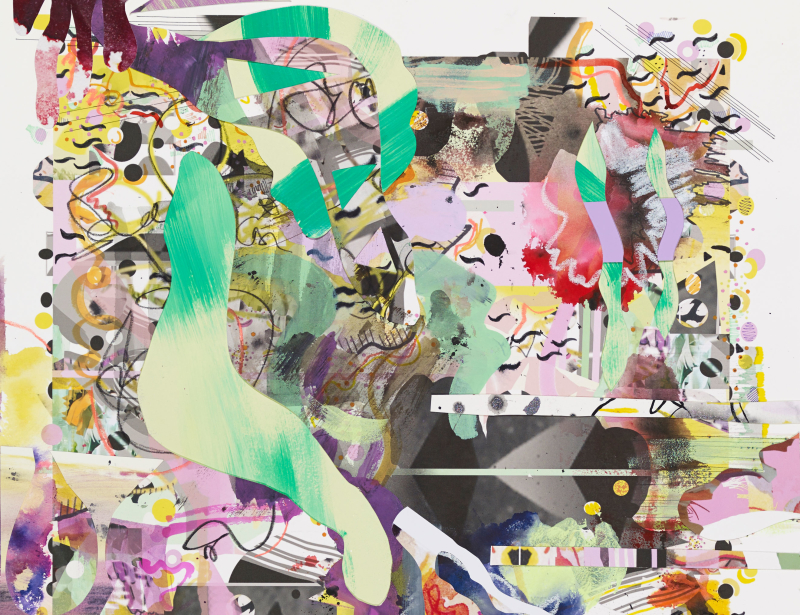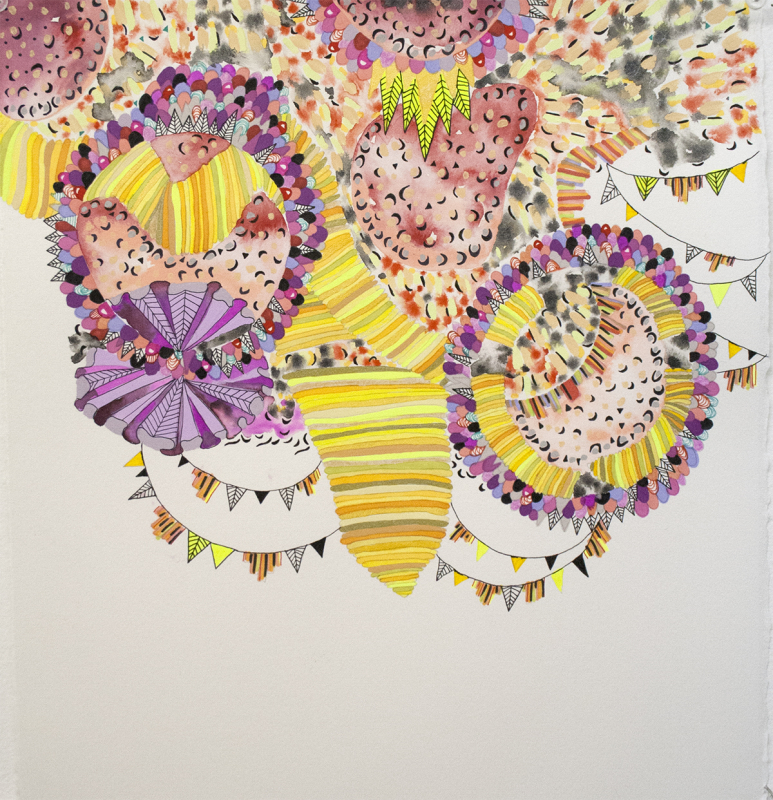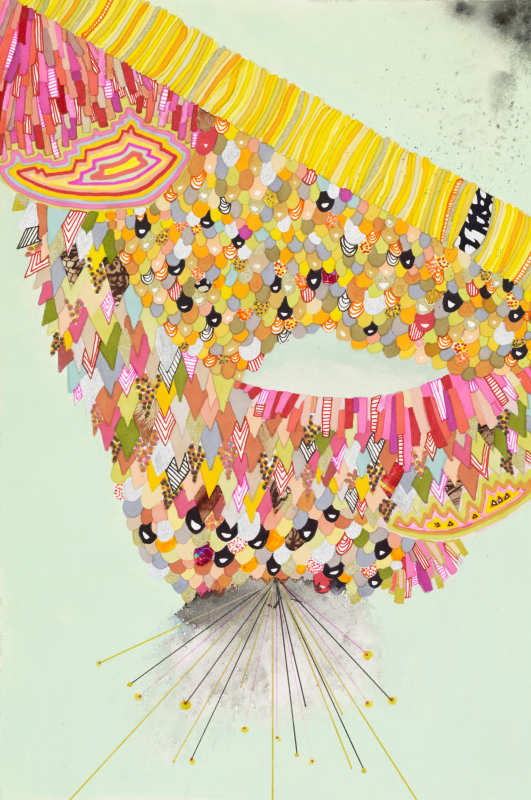Featured Artist Interview: Amy Boone-McCreesh
Amy Boone-McCreesh is a visual artist based out of Baltimore, Maryland. Her pieces are bold and vibrating, with a balance between 2D and 3D works. Initially inspirational for that reason, I came to learn that her work reflects a quality that is rooted in a unique form of the human experience. With patterns, collage, shapes, and color, Amy's work is a study of expressions, displays, and decoration during celebratory or funerary events in a variety of cultures. In this interview, we discuss the connection between pattern and the human experience in her work.
PB: How would you describe your work and what is it inspired by?
A: My work is mixed media. It’s both 2D and 3D, and most recently, I’ve been thinking about how these two can interact and feed one another. The piece Divine Minnie, from one of my newest bodies of work, is an example of a merge between my 2D and 3D work. The patterns contained in the printed vinyl were created from scanned drawings and much of the fabric in the body of the piece is printed with patterned fabric that I have also created from previous 2D works. My work is inspired by human beings. Our desire to commemorate important moments in time through visual displays is really interesting. Many of my influences are not art related and are more inspired by ceremony and rituals across the world. It is my desire to create objects and images that feel important or functional, but the viewer isn’t quite sure of the origin. My aesthetic is fairly maximal and colorful; I enjoy being overwhelmed by visuals.
PB: Is your work influenced or inspired by pattern? Or do you see pattern as a result of your work's other influences?
A: Yes, my work is very much inspired by patterns, even if they don’t always stay intact for the final iteration of my work. Patterns are also an inherent part of many of my influences, such as textiles and rugs. Even if I do not deliberately intend to create patterns, they often find their way into my visual vocabulary and process.
PB: What makes you feel drawn to pattern?
A: I am drawn to pattern because there is something very comforting about them. They are anticipated visual modules and I think human beings are attracted to things and visuals they can understand. The most interesting and best part for me is that in large quantities there’s the potential for patterns to become infinite, and ultimately visually overwhelming. The line between comfort and bombardment is something I currently explore. Patterns are steeped in history and can provide comfort and uniformity. They can also be awe-inspiring. The human application of something that is already found in nature speaks to me in the same way that cultural decorations or ceremonial ephemera do, humans are really amazing in that sense. I’m also obsessed with weavings, quilts, rugs, and handmade tribal objects and garments. These things feel innocent and beautiful to me in a way that contemporary art can’t be.
PB: You've mentioned that your work is inspired by funeral and celebratory decoration in cultures. Why are you drawn to this sort of decoration?
A: I am drawn to pattern in decoration, and specifically funerary and celebratory decorations, because I think that this is something that all human beings can share. Regardless of class, geographic location, or even time period, human beings again and again feel the need to visually mark important moments in time. Often there’s a ritual involved, something repetitive like stringing flowers or cutting paper, which is a physical pattern that provides comfort. This feels very sincere to me. It’s something we all need to do. On the other hand, decoration, opulence, and pattern also acts as a social marker. So even though decoration almost knows no bounds in terms of who participates, it’s easy to separate class or social structure based on how we apply decoration. I’m not sure how or why this has become the primary influence in my work. I’ve always been drawn to other worlds outside of my own. My mother is from England, and we traveled when I was young, so maybe realizing then that there was more to the world really stuck with me.
PB: Do you see an important connection between pattern and funeral and celebratory decoration? Describe how this connection is expressed in your work.
A: Yes, I do see pattern playing a role in these decorations, and ultimately ceremonies. I apply this to my work through process, the physical output, and ultimately the art. I find myself doing a lot of repetitive mark-making, or physical actions like cutting paper or fabric in my studio practice. That can become meditative and comforting. The influence is also apparent in both my 2D and 3D work because of the way the works are arranged to feel like important objects, or worlds. I feel like I am trying to create my own visual culture.
PB: Your sculptural and 2D work clearly communicate with each other and have a similar aesthetic. What is the difference of the two for you?
A: The difference between my 2D and 3D work is becoming less and less, and I am working to close that gap. Recently, I've scanned images of old work, created digital collages and patterns in Photoshop, and then had this imagery printed on fabric and vinyl. This way I can reference myself and create 2D and 3D works that are actually made from one another. For example, the printed fabric may get cut up and put back into a 3D piece. I really want to create a world with my own visual vocabulary in which viewers and participants can get a little lost.
PB: Describe your studio space. What does it look like, and what does a day in the studio look like for you?
A: My studio space is a little chaotic. As much as I long for an organized studio space, I fear that it would hamper my creative output. I often work on multiple pieces at once and how I jump between projects depends on my mood and deadlines. Sometimes I will get stuck on a piece and I found that when I work on a different piece it often frees up my brain to figure out how to solve the problem of the first piece. Since my work is so influenced by the piece that came before it, or because I have started to think about creating these “worlds” rather than individual pieces, I try to maintain a fluid visual vocabulary that can be applied in a variety of mediums. I keep a lot of books and magazines in my studio, such as interior design, Native American and African Tribal Decoration books, and Modern Chinese Arts and Crafts books. In my studio I do have a computer for digital applications and projects, but I do not have the internet, as much as I want to use it for good, it usually just becomes a terrible distraction!
PB: How do you see the influence of pattern in contemporary art?
A: I feel like the lines between art, design, and fashion merge more and more in the contemporary world. I think that pattern encourages this because it works in painting, fashion, textiles, graphics, murals, and more. I think pattern helps to push the tastes of mass-consumers of art and design in a better direction. Pattern is so steeped in human history that it only makes sense that it continues to drive us forward in terms of visuals. Pattern is an equalizer that requires no background knowledge for the viewer, which makes people feel good, because they aren’t excluded from enjoyment of the visuals. I think Contemporary Art is sometimes guilty of this exclusion and ultimately, the joy of viewing art.
PB: What direction do you see your pieces taking in the future?
A: For the future, I see the combination of my 2D and 3D works more and more. I think about my work more as installation and how these parts exist together, rather than individual pieces. I currently imagine environments that envelope viewers in a variety of ways, rather than just looking at a piece of art. I am going to get fabric printed and and I think about textiles and design beyond the fine arts world. I would love to explore fashion or wearable works.
PB: Any important events that our readers should know about?
A: Yes, I will have an interview and sale of six small original works on paper for Buy Some Damn Art in the coming month. I am also working on a collaborative project funded by a Rauschenberg Foundation Grant at School 33 in Baltimore, MD. It is a public art piece that is very pattern heavy! It officially opens September 6th. You can also see my work right now the Pennsylvania College of Art and Design the Arlington Arts Center, both until October of this year.
For more of Amy Boone-McCreesh's work, visit her website at www.amyboonemccreesh.com














